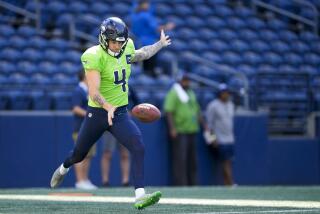Working out on the fly
- Share via
Fast-moving, physical and smart, Ultimate Frisbee is no day at the beach, as the throwing of the disc often is portrayed. Instead, it’s an extremely demanding cardiovascular workout that emphasizes three things -- running, running and running.
In the world of sports, Ultimate is a relative newcomer. Though accounts differ somewhat, the game seems to have been developed on high school and college campuses in the counterculture years of the late ‘60s and early ‘70s. The first college game was played between Rutgers and Princeton in 1972, according to the World Flying Disc Federation. Apparently, the same two universities faced each other in the first intercollegiate football game on exactly the same ground 103 years earlier.
Probably due in part to its roots, the game seems to be popular among the well-educated, particularly those who, to a certain degree, have rejected the American jock’s holy triumvirate of football, basketball and baseball. Today, the game is played in more than 40 countries by more than 100,000, according to the World Flying Disc Federation.
One aspect of the sport, which turns out to be quite beneficial for beginners, is an Ultimate philosophy known as “spirit of the game.” Essentially, it means sportsmanship -- placing love of the game and respect for others well above the goal of winning.
It may sound hokey, and familiar -- what sport doesn’t like to think of itself as fostering good sportsmanship? But in this case, Ultimate should receive a great deal of credit for striving to live up to its credo. Even at the highest levels of national and international competitions, there are no referees. Players are expected to call fouls against themselves.
And if the coed pickup game I joined recently at Lake Hollywood Park is any indication, the atmosphere is quite amiable despite the intense competition and occasional grumbling. (Pickup games across Los Angeles and Orange counties are easy to find at www.laout.org).
Ultimate, which blends elements of soccer and touch football, is a fairly easy game to learn. Basically, two seven-person teams face each other on a field that is 70 yards long and 40 yards wide. Incidental contact can occur when two opponents leap for a disc, but otherwise physical clashes are discouraged.
The object is to get the disc into the opponent’s end zone. Games continue until one side reaches 15 points, but like many things in Ultimate, this is often negotiable. Usually, games last an hour or so.
The disc can be advanced up the field only by throwing it to a teammate; once players catch the disc, they cannot run with it. An opposing player tries to block the next throw to any of the six scrambling members of the team. But if the disc is dropped, thrown out of bounds or intercepted, it’s a turnover.
The game begins with a “pull,” what a football fan might call a kick-off. The defense wisely tried to exploit my new skills as many of the pulls came toward me. Although my throwing skills were somewhat suspect, I managed to catch the disc just fine.
My strategy was simple: Toss the disc to a more experienced teammate as quickly as possible, and run down the field in hopes of catching a pass. If I delayed, I could face a difficult throw for a newcomer like me -- the dreaded forehand.
As a right-hander, this is where I would throw the disc from the right side of my body with a whip-like motion that would sail perfectly parallel to the ground to a teammate. In practice, before the game, however, I had a lot of trouble with this throw, as most beginners do, resulting in many inaccurate tosses.
Thus, throughout the game, I stuck to the basic backhand, the same one I’d learned on a beach decades ago. Luckily, I could throw it reasonably accurately and with some zip.
But again my self-consciousness about my lack of skills wasn’t necessary. The players in the weekly pickup game in the shadow of the Hollywood sign were good-natured. Before the game, several players offered friendly tips.
From the opening pull, it quickly became clear that the game probably had as much to do with a player’s overall fitness level as anything else. Good players without the disc should constantly be in motion, trying to get open or defending an opponent. Defensive strategies can be more complex in team and tournament play, but in pickup games like ours, players usually guard the opponent directly opposite them on pulls.
I tried to keep moving -- mixing jogging, running and sprinting. After about 10 or 15 minutes of that, I felt ready for an oxygen mask. Luckily, I wasn’t the only player breathing heavily. Although the talent ranged from advanced to beginner, most players seemed just as winded.
Because the game started more than an hour later than advertised, I had to leave early. I was tired, but ready for more.
I’m not sure if I’d used the word ultimate -- penultimate, maybe. But there’s a lot to be said for running around on a green field on a sunny day living up to the spirit of the game.
*
Snapshot: Ultimate Frisbee
Duration of activity: 31 minutes
Calories burned*: 488
Heart rate*: average, 155; high, 187.
*This information was obtained using a heart-rate monitor.
*
Martin Miller can be reached at martin.miller@latimes.com.
More to Read
Go beyond the scoreboard
Get the latest on L.A.'s teams in the daily Sports Report newsletter.
You may occasionally receive promotional content from the Los Angeles Times.









